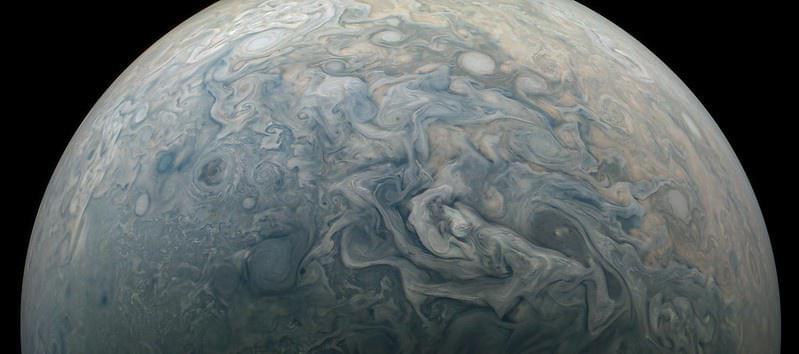Go Inspiration4, go SpaceX 👍👨🚀



NASA’s Juno spacecraft orbiting Jupiter has sent back another batch of stunning photos of the giant planet.
The $1.1 billion spacecraft, which recently marked the tenth anniversary of its launch, has been orbiting Jupiter since 2,016 but recently entered a new second phase of its mission after completing its core five-year survey of the giant planet.

BAE Systems unveiled its ultra-small MicroGRAM-M global positioning system (GPS) receiver compatible with next-generation M-Code military GPS signals that are resistant to jamming and spoofing.
According to the defense company, about the size of a postage stamp, MicroGRAM-M is “the world’s smallest, lightest, and most power-efficient M-Code embedded GPS receiver.” The GPS receiver is intended to enable assured positioning, navigation, and timing (PNT) for size-constrained and other micro-applications.
MicroGRAM-M features rapid, secure GPS signal acquisition, enhanced security and resiliency, anti-jamming, and anti-spoofing capabilities. At its heart is a proven, tamper-proof M-Code Common GPS Module that encapsulates classified data and signal processing, according to the manufacturer.


Many benefits have already been linked to the Mediterranean diet, and additional studies continue to examine its health effects that reveal other reasons to follow it.
This diet, based on a menu that contains whole grains, healthy fats, a large variety of fruits and vegetables and is relatively low in dairy products and red meat, is considered one of the healthiest diet lifestyles to keep.
Past research already established this diet’s contribution to prolonging life expectancy, as it reduces the risk of cardiovascular disease and also certain types of cancer, diabetes, dementia and more. Now, a new study finds that the Mediterranean diet is also beneficial for sexual function, improves blood circulation in general and also specifically for the penis, and is associated with higher levels of testosterone.
A new study presents interesting findings on the link between the Mediterranean diet and improved sexual function, especially for men of a certain age.

“After demonstrating that cultured meat can reach cost parity faster than the market anticipated, this production facility is the real game-changer,” said Yaakov Nahmias, Future Meat Technologies founder and chief scientific officer, in a press release. “This facility demonstrates our proprietary media rejuvenation technology in scale, allowing us to reach production densities 10-times higher than the industrial standard.”
Cultured meat is made by extracting cells from animal tissue and giving them nutrients, oxygen, and moisture while keeping them at the same temperature they’d be at inside an animal’s body. The cells divide and multiply then start to mature, with muscle cells joining to create muscle fibers and fat cells producing lipids. The resulting nuggets of meat can be used to make processed products like burgers or sausages. Structured cuts of meat with blood vessels and connective tissue, like steak or chicken breast, require scaffolds, and researchers are creating these with biomaterials, like cellulose from plants. Companies are working on several varieties of more elaborate cultured products, from bacon to salmon.
As reported by Bloomberg, Future Meat aims to start offering its products in US restaurants by the end of next year—but must get approval from the FDA first. On top of that approval, public opinion is another hurdle the company and its competitors will need to clear before they see widespread success; for every person who’s opposed to factory farming, there’s a person who’s squeamish about the idea of meat grown in a bioreactor, despite the avian (or bovine, or porcine) lives being spared. Getting these consumers to view cultured meat favorably will be a matter of education, taste/texture as compared to the ‘real thing,’ and cost competitiveness.

“I think this virus is here to stay with us and it will evolve like influenza pandemic viruses, it will evolve to become one of the other viruses that affects us,” Dr. Mike Ryan, executive director of the World Health Organization’s Health Emergencies Program, said at a press briefing.
Covid-19 could become endemic like the flu and circulate in the population at low levels.
And just like a unicorn, it doesn’t currently exist.
Never mind buying a robot dog for your kids — you might just get them a mythical creature instead. Chinese EV maker Xpeng has teased a robot unicorn meant for children to ride. As SCMP notes, the quadruped will take advantage of Xpeng’s experiences with autonomous driving and other AI tasks to navigate multiple terrain types, recognize objects and provide “emotional interaction.”
The company is shy on most other details, although the design looks and trots like a cuter, more kid-friendly version of Boston Robotics’ Spot. It’s appropriately about as tall as a child. Sorry, folks, you won’t prance your way to work.
This robot unicorn is just about as mythical as the ‘real’ thing, too. Xpeng hasn’t revealed when it expects to deliver its robotic horse-with-a-horn, let alone pricing or availability. It might not cost as much as a $75,000 Spot, but we’d expect something this sophisticated to cost more than the $2,900 Aibo from 2019.
new study shows.
When you know you’re being watched by somebody, it’s hard to pretend they’re not there. It can be difficult to block them out and keep focus, feeling their gaze bearing down upon you.
Strangely enough, it doesn’t even seem to really matter whether they’re alive or not.
In new research, scientists set up an experiment where people played a game against a robot.